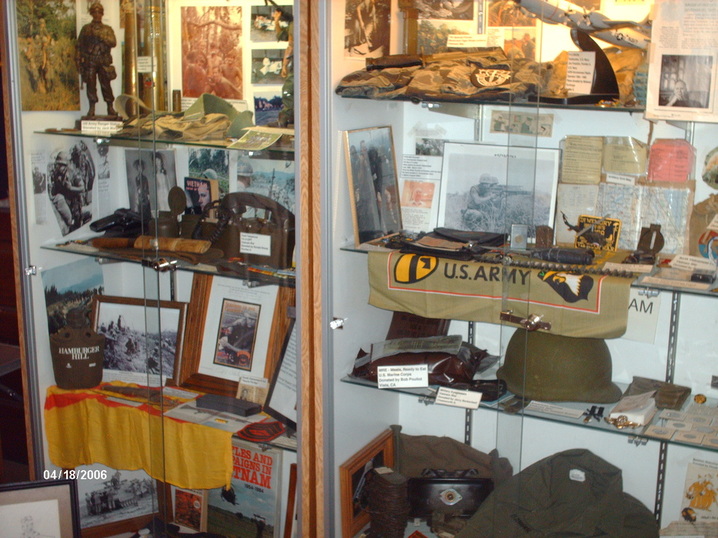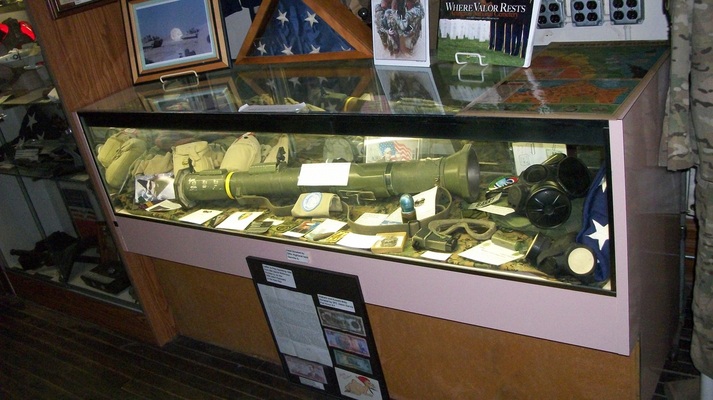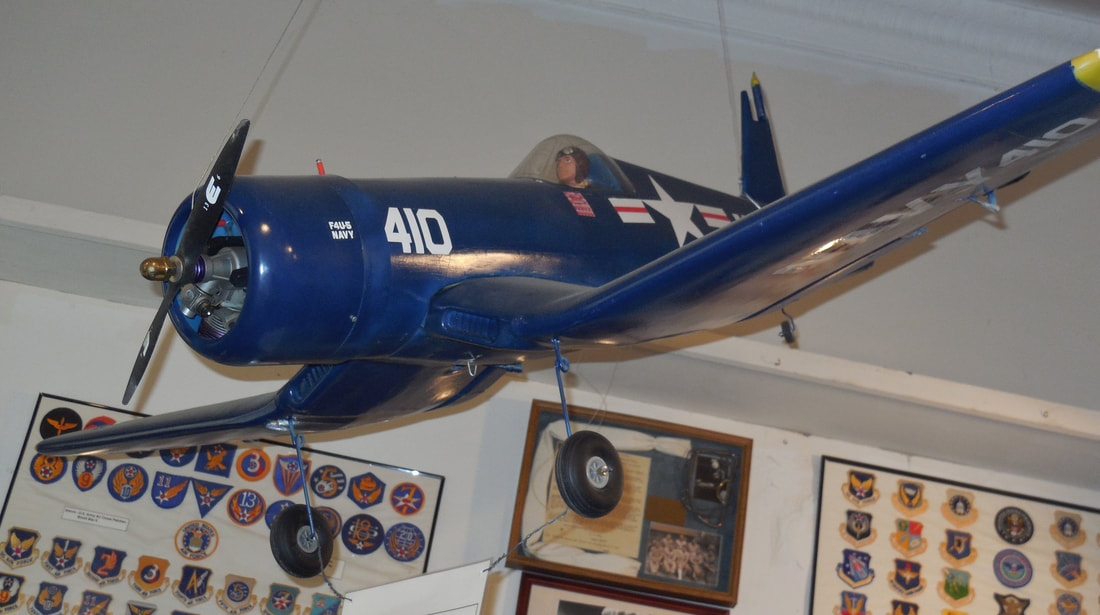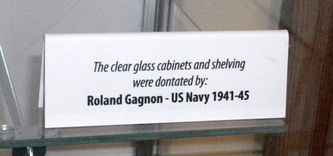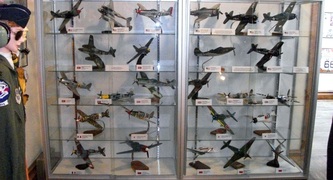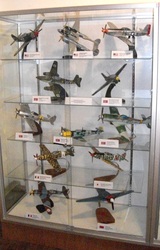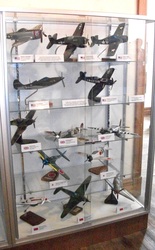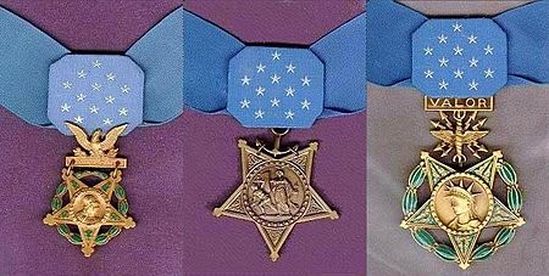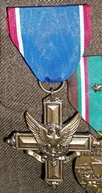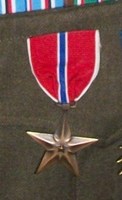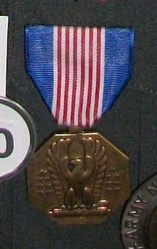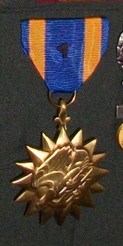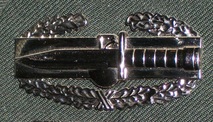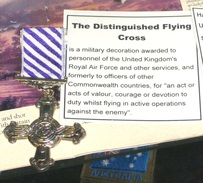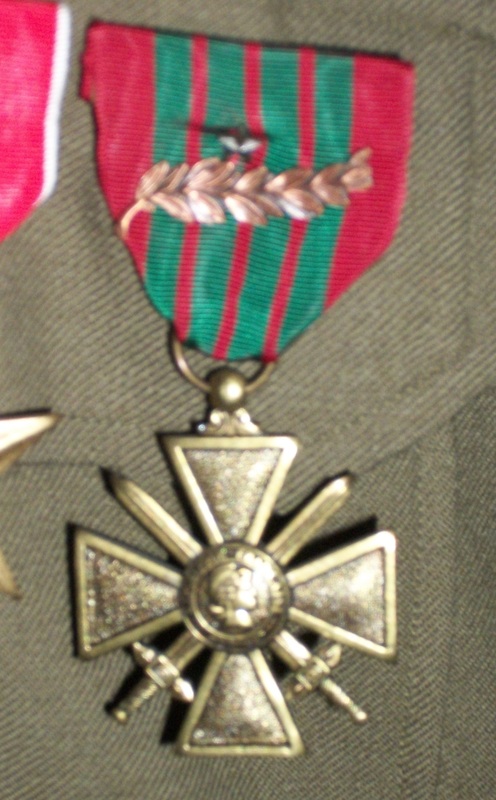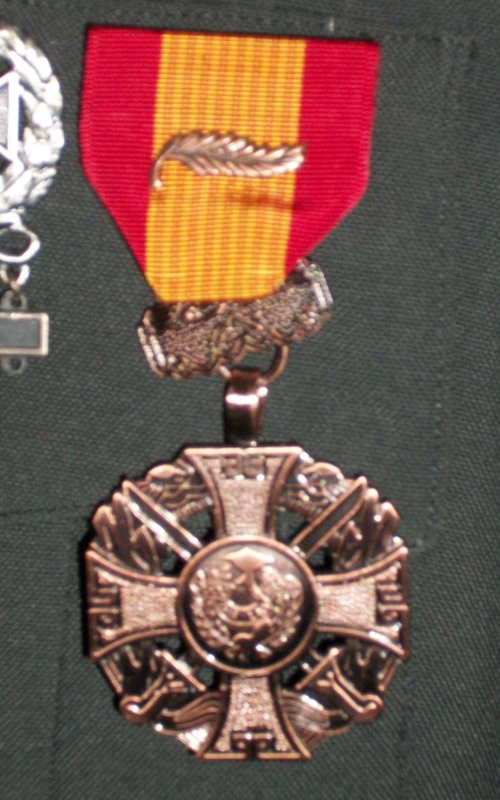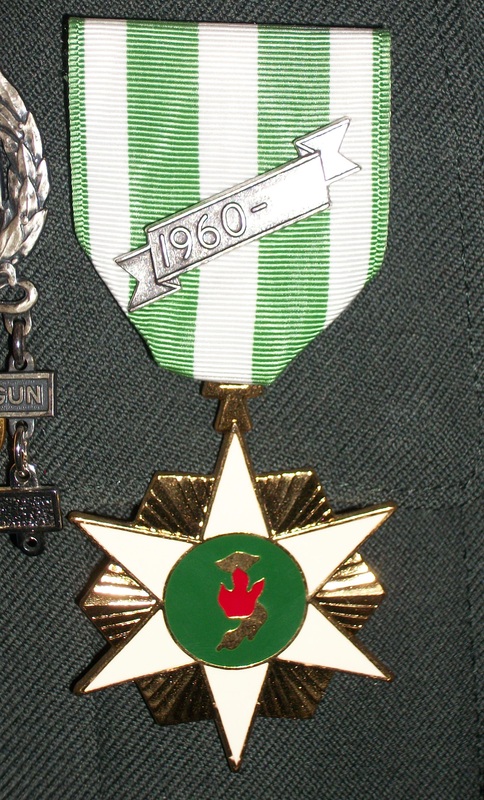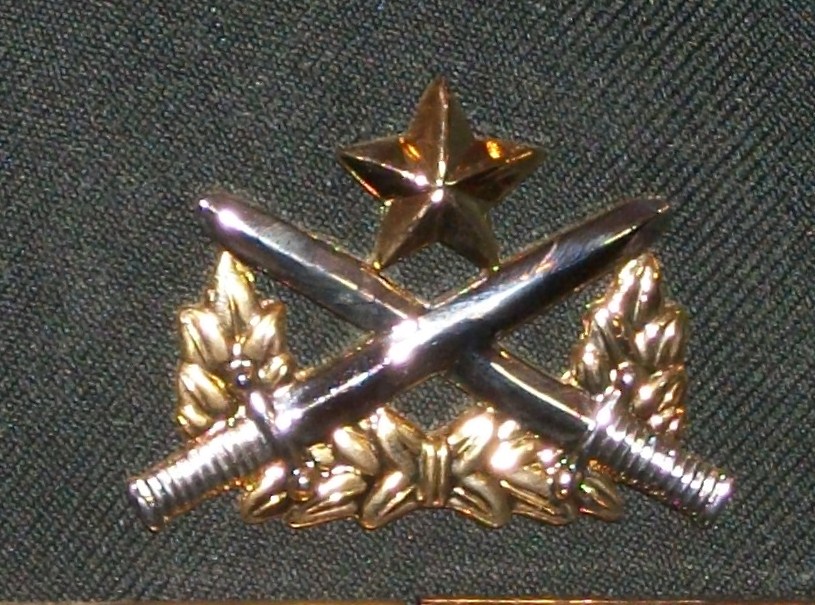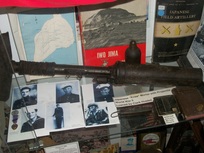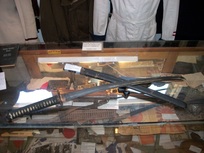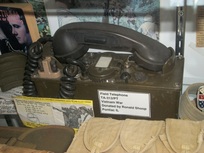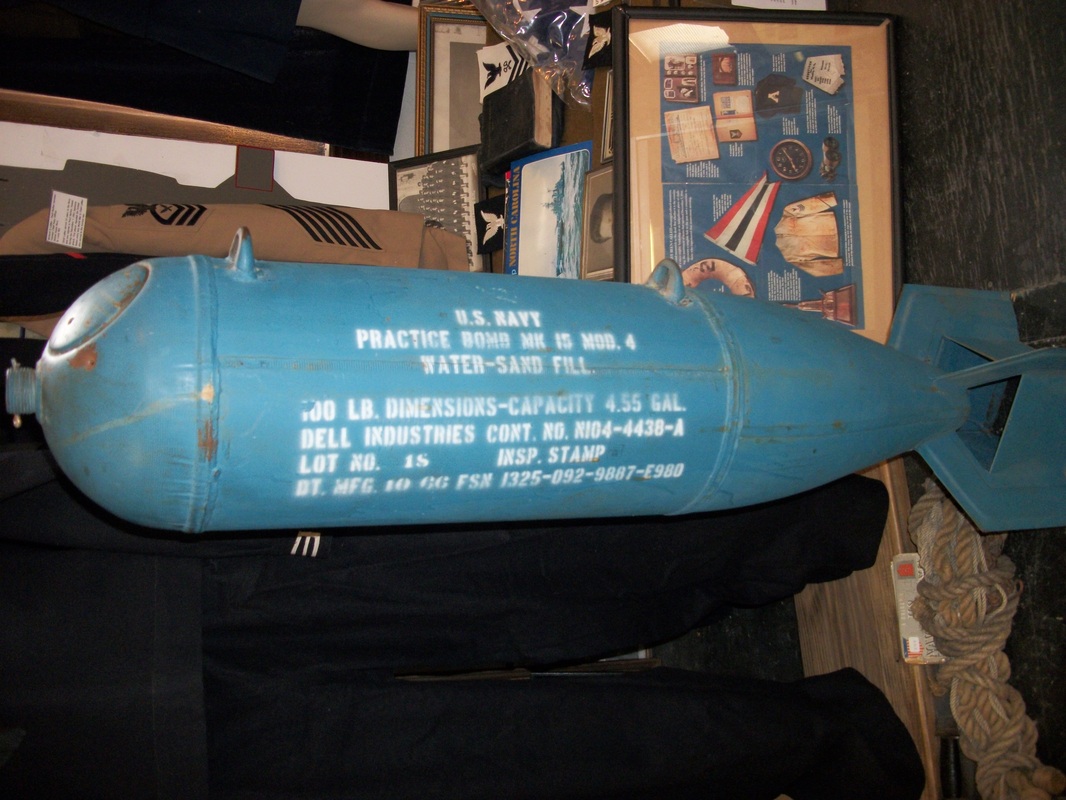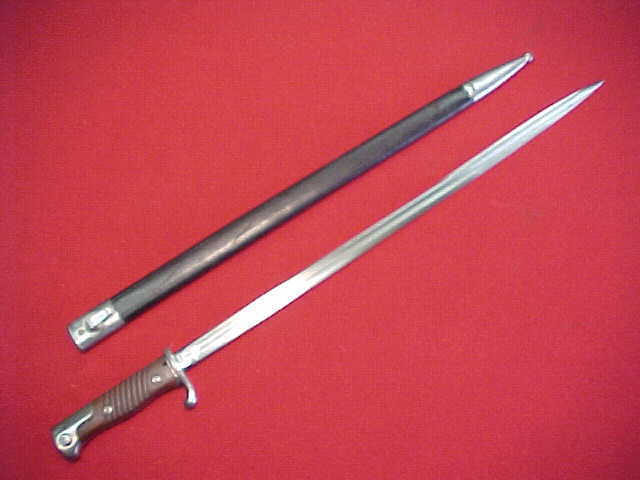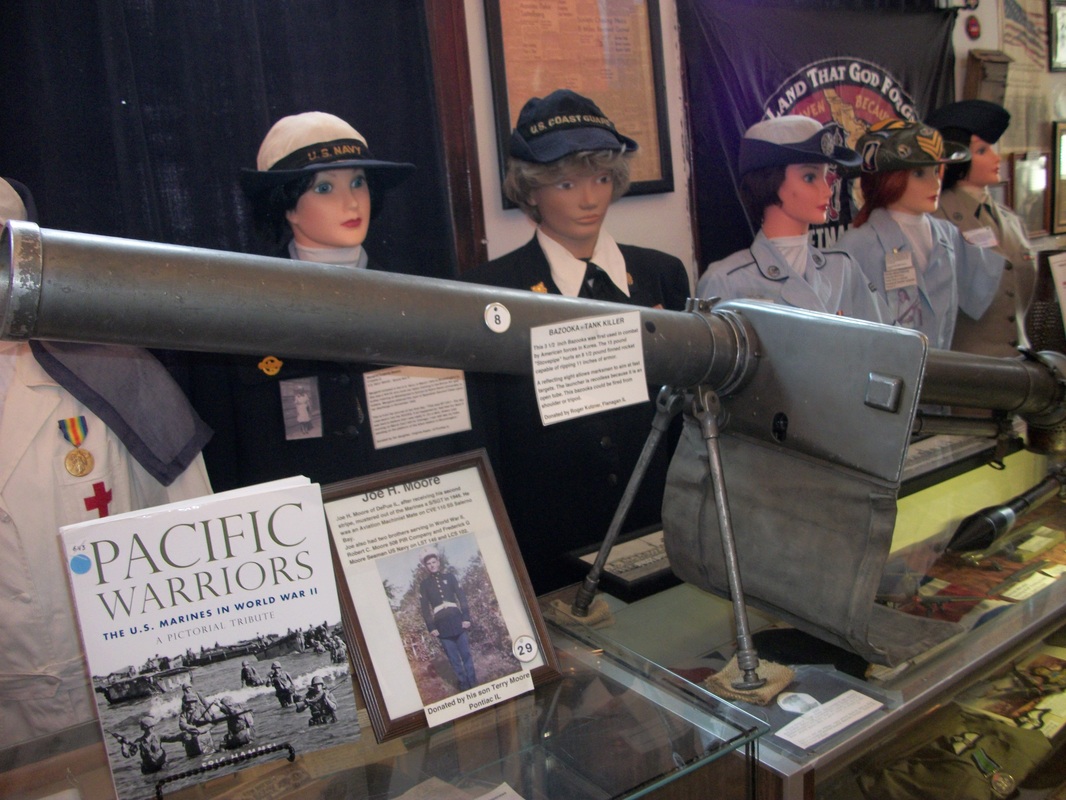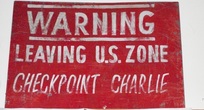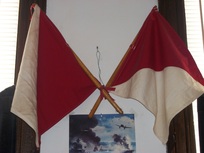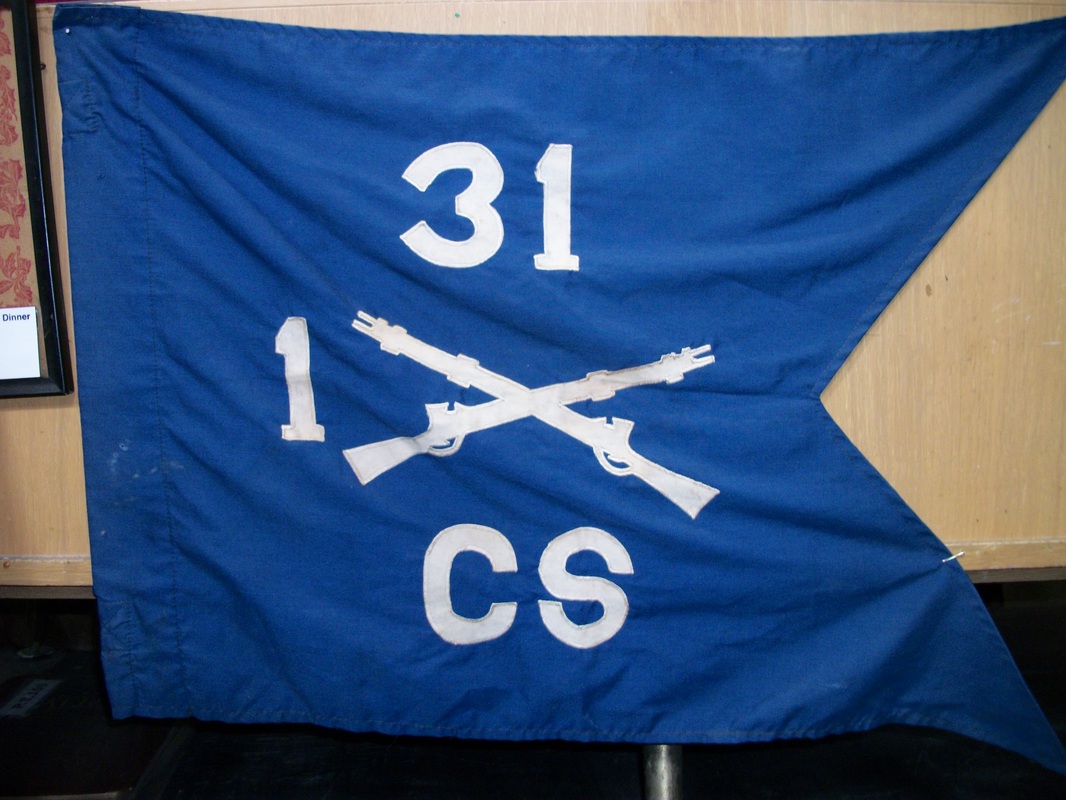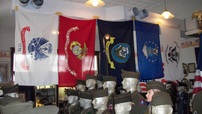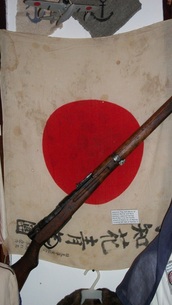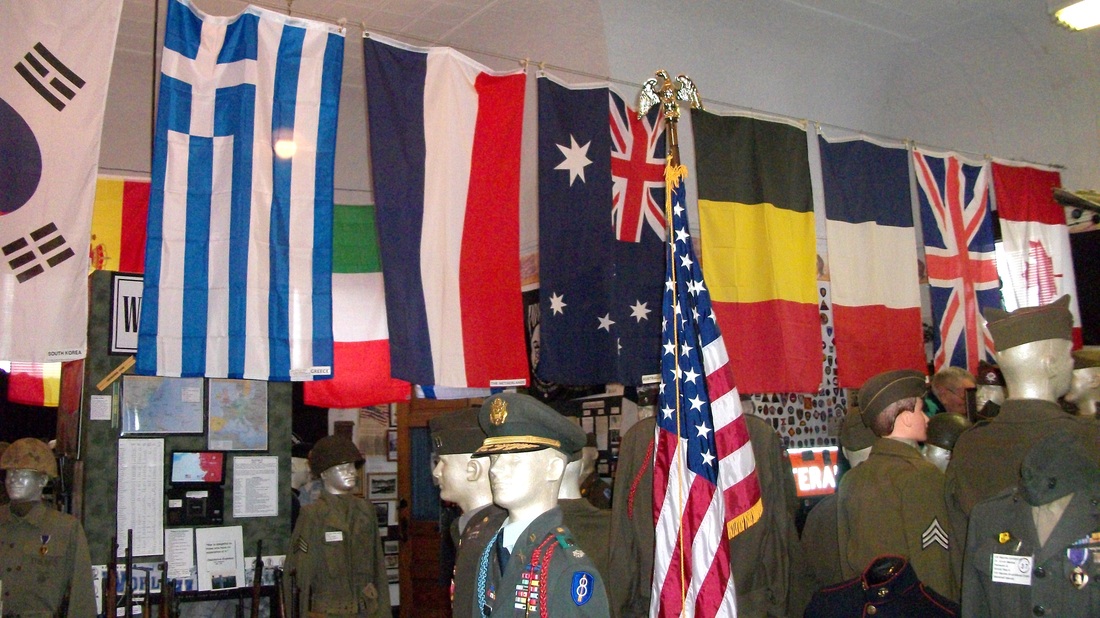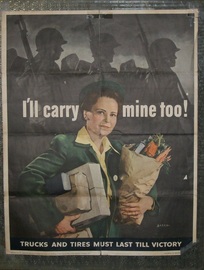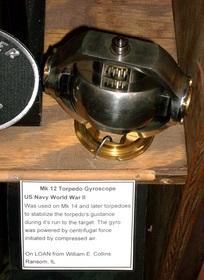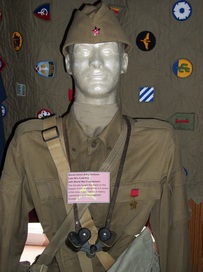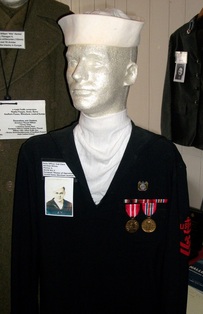Artifacts
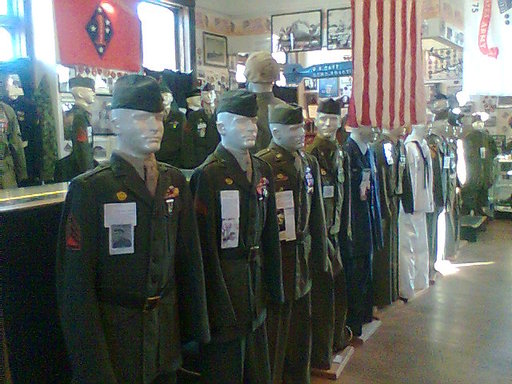
We have more than 275 uniforms on mannequins honoring veterans as well as cases displaying weapons, radios, meal rations, photos, equipment and other military related items donated and loaned to the museum by the veterans themselves and their families. Since the museum is constantly evolving, some of the photos here may not reflect the current display. To see what's new, stop by and see.
Some of the many display cases in the museum.
Shadow Box Frames
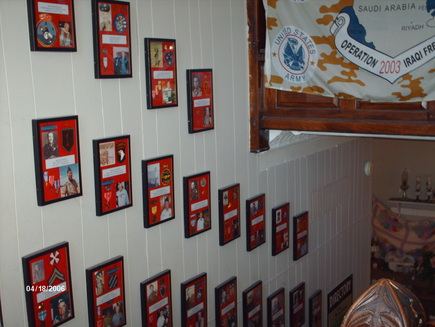
In addition to mannequins, veterans are honored with shadow box frames depicting their awards, photos and various uniform insignia. Some of the veterans honored in shadow box frames also have uniforms on mannequins on display in the museum.
The Battlefield Cross
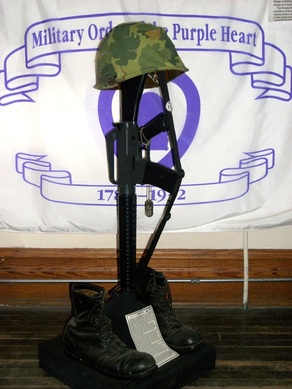
The Fallen Soldier Battle Cross, Battlefield Cross or Battle Cross is a symbolic replacement of a cross on the battlefield or at the base camp for a soldier who has been killed in action or in the line of duty. Made up of the soldier's rifle with bayonet attached stuck into the ground, helmet on top, dog tags sometimes hanging from the rifle and the boots of the fallen soldier next to it. Its purpose is to show honor and respect for the fallen at the battle site. The practice started during the Civil War or possibly earlier as a means of identifying the locations of bodies on the battleground before they were removed.
Video Kiosk
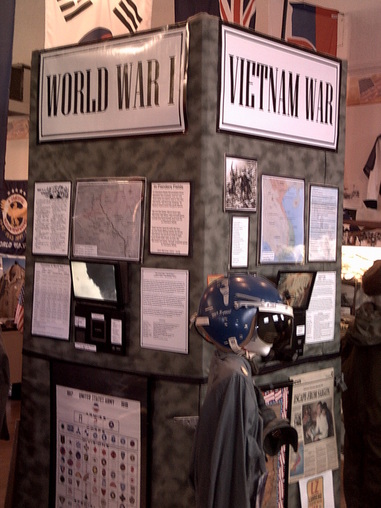
In the main room we have a kiosk with DVD players showing videos from World War I, World War II, the Korean War and the Vietnam War. Also on the kiosk there are various maps, photos and statistics for that particular conflict.
Historic Models

Also on display are models of historic ships, boats and aircraft. Some of the models are made from a kit and others are made from scratch.
New addition to the Museum. World War II model fighters. Models were donated by Donald Fortna of Pontiac. The display cases were donated by museum member Rollie Gagnon.
Medals, awards and badges
The museum has many US and foreign medals, ribbons, badges and insignia on display on uniforms and in display cases. Whenever possible we try to display the original decorations awarded to the service member. Shown below are some examples of military decorations and awards that are represented or actually displayed in the museum. They are not necessarily shown in proper order of precedence.
The Medal of Honor
The Medal of Honor is the highest award for valor the United States can bestow on a member of the military. We have one replica World War II era Medal of Honor on display and a Medal of Honor earned during the Civil War and awarded in 1897 also on display.
distinguished service cross
The Distinguished Service Cross is the second highest military award that can be awarded to a member of the United States Army (and previously, the United States Army Air Forces), for extreme gallantry and risk of life in actual combat with an armed enemy force. Actions that merit the Distinguished Service Cross must be of such a high degree that they are above those required for all other U.S. combat decorations but do not meet the criteria for the Medal of Honor. The Distinguished Service Cross is equivalent to the Navy Cross (Navy, Marine Corps, and Coast Guard) and the Air Force Cross (Air Force).
|
silver star
The Silver Star, officially referred to as the Silver Star Medal by all of the United States Armed Forces, is the third highest military decoration for valor that can be awarded to any person serving in any capacity with the United States Armed Forces. The medal is awarded for gallantry in action against an enemy of the United States.
|
bronze star medal
The Bronze Star Medal may be awarded for acts of heroism, acts of merit, or meritorious service in a combat zone. When awarded for acts of heroism, the medal is awarded with the "V" device.
|
purple heart
The Purple Heart is awarded in the name of the President to those who have been wounded or killed while serving on or after April 5, 1917. With its forerunner, the Badge of Military Merit, which took the form of a heart made of purple cloth, the Purple Heart is the oldest military award that is still awarded to members of the U.S. military.
|
Distinguished Flying Cross
The Distinguished Flying Cross is awarded to any officer or enlisted member of the United States Armed Forces who distinguishes himself or herself in support of operations by "heroism or extraordinary achievement while participating in an aerial flight, subsequent to November 11, 1918."
|
Soldier's Medal
The Soldier's Medal is an individual decoration of the United States Army. It was introduced as Section 11 of the Air Corps Act, passed by the Congress of the United States on July 2, 1926. The criteria for the medal are: "The Soldier's Medal is awarded to any person of the Armed Forces of the United States or of a friendly foreign nation who, while serving in any capacity with the Army of the United States distinguished himself or herself by heroism not involving actual conflict with an enemy."
|
Air Medal
The Air Medal was created in 1942 and is awarded for meritorious achievement while participating in aerial flight.
|
Campaign and Service Medals
Campaign and service medals are awarded to and by all branches of the military, the Department of Defense, international peacekeeping organizations and foreign countries to indicate service in a particular campaign, war, operation or period of time. Devices such as oak leaf clusters, service stars, numbers and others indicate additional awards or additional actions within the campaign or service the medal was awarded for. Shown above are the American Campaign Medal, the Asiatic-Pacific Campaign Medal and the Navy of Occupation Medal. All are World War II awards.
|
Combat Infantryman Badges
The Combat Infantryman Badge (CIB) is awarded to infantrymen and Special Forces Soldiers in the rank of Colonel and below, who personally fought in active ground combat while assigned as members of either an infantry, Ranger or Special Forces unit, of brigade size or smaller, any time after 6 December 1941. The CIB and its non-combat contemporary, the Expert Infantryman Badge (EIB) were simultaneously created during World War II to enhance the morale and prestige of service in the infantry. Specifically, it recognizes the inherent sacrifices of all infantrymen, and that, in comparison to all other military occupational specialties, infantrymen face the greatest risk of being wounded or killed in action. There are 2nd, 3rd and 4th awards for those who fought in multiple wars.
|
Combat Medical Badges
The Combat Medical Badge is award of the United States Army which was first created in January 1945. Any member of the Army Medical Department, at the rank of Colonel or below, who is assigned or attached to a medical unit (company or smaller size) which provides medical support to a ground combat arms unit during any period in which the unit was engaged in active ground combat is eligible for the CMB. According to the award criterion, the individual must be performing medical duties while simultaneously being actively engaged by the enemy; strict adherence to this requirement and its intrepretation (e.g., distant mortar rounds vs. direct small arms fire) will vary by unit. As of June 3, 2005, Special Forces medics are no longer eligible for award, but may now receive the Combat Infantryman Badge. A revision has allowed aviation medics to be eligible for the CMB. There are 2nd, 3rd and 4th awards for those who served in multiple wars. The non-combat proficiency equivalent is the Expert Field Medical Badge.
|
Combat Action Badges
The Combat Action Badge (CAB) is worn by U.S. Army soldiers. The Combat Action Badge may be awarded to any soldier not eligible for the Combat Infantryman Badge (CIB) or Combat Medical Badge (CMB) after the date of September 18, 2001 performing duties in an area where hostile fire pay or imminent danger pay is authorized, who is personally present and actively engaging or being engaged by the enemy, and performing satisfactorily in accordance with the prescribed rules of engagement. The CAB may be awarded to any branch of service or military occupational specialty including infantryman except when serving in a role where they would be eligible for the Combat Infantryman Badge.
There are 2nd, 3rd and 4th awards for those who fought on multiple wars. However, under current criteria, only ONE CAB may be awarded for the Global War on Terror in all operations. |
Parachutist Badges
The Army's Basic Parachutist Badge is awarded to all military personnel of any service who complete the US Army Basic Airborne Course at Fort Benning, Georgia. It signifies that the soldier is a trained military Parachutist, and is qualified to participate in airborne operations. As of June 2011, the badge and its sew-on equivalent may be worn on the Army Combat Uniform (ACU) and Multicam uniforms. This badge can also be awarded in Senior and Master badges to indicate Jumpmaster level as well as an increasing number of jumps. Soldiers assigned to Army units on airborne status wear a cloth oval background trimming underneath their Parachutist Badge, which shares the basic design of the unit's beret flash. This is one method by which an individual can identify a parachute qualified Soldier verses an active parachutist, better known as a "Paratrooper." The original flash was also a contribution of William P. Yarborough. The badge above indicates assignment to the 2nd Ranger Battalion.
|
foreign medals and badges
distinguished flying cross
|
croix de guerre
|
gallantry cross
|
vietnam campaign medal
|
republic of vietnam ranger badge
|
parachutist badge
|
equipment and weapons
munitions
Above are artillery, mortar and cannon rounds of various sizes. Some are inert training rounds and others are spent or non-fireable rounds. The museum also has rifle and pistol ammunition and both hand and launchable grenades on display. All munitions are inert and completely safe.
|
Japanese type 89 grenade discharger
The Type 89 Grenade Discharger, inaccurately known as a knee mortar by Allied forces, is a Japanese grenade launcher or light mortar that was widely used in the Pacific Ocean theater of World War II. Many allied soldiers suffered broken legs because they incorrectly assumed the spade on the bottom of the weapon was to support the weapon on ones leg.
|
rifles
We have rifles from several nations dating from 1879 thru the Korean War. A majority of the rifles and pistols in the museum are fully functional and are commonly demonstrated to visitors. All that are not in display cases are available for closer inspection.
|
wakizashi sword
We have a Japanese Wakizashi sword taken from a Japanese soldier in WW II. Historically, wakizashi were one of the traditionally made Japanese swords that were worn by the samurai class of feudal Japan in addition to the longer Katana and Tachi swords. Modern versions of the wakizashi are sometimes made using non-traditional materials and methods. This particular sword was handed down many generations within a single Japanese family.
|
TA-312 field telephones
The analog, 2-wire, battery operated TA-312/PT replaced and will inter-operate with the World War II and Korean War EE-8 field phone. The rugged and reliable TA-312 was used from the 1950s through the 1980s before being superseded by the TA-838 analog field phone. TA-312's continue in use throughout the U.S. forces as well as many allied countries.
The TA-312/PT (and the earlier, similar TA-43/PT) may be used in a point-to-point wire system or in any two-wire ring-down subscriber position of a telephone communications system. The museum has 4 and plans are underway to connect 2 of them so that visitors can experience military communications. |
inert "dummy" practice bombs
The museum has several INERT Practice Bombs. These INERT DUMMY Practice Bomb are manufactured specifically for training purposes and cannot be made to explode. They are filled with either sand or water to simulate real bombs for training of ordnance personnel and test aircraft under simulated full bomb loads.
|
bayonets
The 1898 bayonet, (shown above), could be used on any rifle based on the Mauser 98/K98 design. The bayonet could be fitted to rifles from many nations that were made from 1898 through roughly 1945. The museum also has bayonets from many nations that could be fitted to nearly every rifle used from WW I through the Vietnam War.
|
Bazooka "tank killer"
The museum has a deactivated Spanish M65 bazooka, (a copy of the US 3.5 inch M20 "Superbazooka). Bazooka is the common name for a man-portable recoilless rocket antitank weapon, widely fielded by the US Army. Also referred to as the "Stovepipe", the innovative bazooka was amongst the first-generation of rocket propelled anti-tank weapons used in infantry combat. Featuring a solid rocket motor for propulsion, it allowed for high-explosive anti-tank (HEAT) warheads to be delivered against armored vehicles, machine gun nests, and fortified bunkers at ranges beyond that of a standard thrown grenade or mine. The Bazooka also fired a HESH round, effective against buildings and tank armor. The universally-applied nickname arose from the M1 variant's vague resemblance to the musical instrument called a "bazooka" invented and popularized by 1930s U.S. comedian Bob Burns.
|
signs, flags and banners
"checkpoint charlie"
This sign was at the US checkpoint between East and West Berlin during the Cold War.
|
NAVY SEMAPHORE FLAGSThe Semaphore flag signaling system is an alphabet signalling system based on the waving of a pair of hand-held flags in a particular pattern.
The flags are usually square, either red and yellow or red and white, divided diagonally with the red portion in the upper hoist. The flags are held, arms extended, in various positions representing each of the letters of the alphabet. The pattern resembles a clock face divided into eight positions: up, down, out, high, low, for each of the left and right hands (LH and RH) six letters require the hand to be brought across the body so that both flags are on the same side. |
army company guidons
In the United States Army, Navy, Marine Corps, and Air Force, a guidon is a military standard that company or platoon-sized elements carry to signify their unit designation and corps affiliation or the title of the individual who carries it. A basic guidon can be rectangular, but sometimes has a triangular portion removed from the fly (known as "swallow-tailed").
Lettered companies (troops and batteries in the cavalry and field artillery respectively) of battalions (squadrons in the cavalry) have guidons displaying the branch insignia, the company letter, and the battalion and regimental numbers. The base color of the guidon is the first named color of the applicable branch, e.g. scarlet for field artillery, with the letters, numerals and insignia applied in the second named color of the branch, e.g. yellow for field artillery. For companies of separate battalions, the branch insignia is centered on the guidon between the battalion number above and the company letter below. For companies of battalions of regiments, the number above the insignia is that of the regiment; the number of the battalion is vertically centered between the insignia and the hoist. Groups use diagonal stripes of the branch's secondary color. |
army infantry division flags
United States Army flags traditionally have been used for purposes of identification and the fostering of esprit de corps.
Continuous recognition of the significance of flags to the morale of members of the Army resulted in the development of a well-defined system of flags for organizations at all echelons. In general, flags incorporate design elements which are identical to or relate to the insignia worn by the members of the organization. Each level of command has their own colors and combinations of colors, design and insignia that are displayed on their organizational flags. Shown above are Division flags for the 25th and 1st Infantry Divisions. All military organizational flags will have streamers indicating battles, campaigns or achievements. The streamer often is an inscribed ribbon with the name and date denoting participation in a particular battle, military campaign, or theater of war. The ribbon's colors are chosen accordingly and frequently match an associated campaign medal or ribbon bar. |
Branch Flags
The several branches of the United States Armed Forces are represented by flags, among other emblems and insignia. Within each branch, various flags fly on various occasions, and on various ships, bases, camps, and military academies.
In general, the order of precedence when displaying military flags together is the U.S. National Colors, U.S. Army, U.S. Marine Corps, U.S. Navy, U.S. Air Force, and U.S. Coast Guard. However, in any period, such as in wartime, where the U.S. Coast Guard is operating as part of the U.S. Navy, the U.S. Coast Guard flag would precede the U.S. Air Force flag. |
captured flags
The museum has several enemy flags captured in the aftermath of a battle. Above is a Japanese flag with writing either identifying the unit or personal messages from family and friends of the soldier. We also have Nazi flags captured in Europe, one with signatures of the soldiers that captured it. The rifle in the photo is a Japanese Type 99 Short rifle made after mid-1945 (also known as the Type 99 "last ditch" rifle). The rifle has no flip-up anti-aircraft rear sight nor monopod.
|
national flags
We have flags of many nations representing international visitors to our museum on display in the two main rooms. Some are sent to the museum by the international visitors themselves.
|
World War II homefront posters
The U.S. used posters more than any other type of propaganda media, and produced more propaganda posters than any other country fighting in World War II. Almost 200,000 different designs were printed during the war.
These posters used a number of themes to encourage support for the war, including conservation, production, recruiting, home efforts and secrecy. Posters were usually placed in areas without paid advertisements. The most common areas were post offices, railroad stations, schools, restaurants and retail stores. Smaller posters were printed for the windows of private homes and apartment buildings. These were places where other propaganda media couldn't be used. |
miscellaneous artifacts and displays
MK-12 torpedo gyroscope
Gyroscopes are used in torpedoes to keep the torpedo on a straight course to the target. Prior to firing, compressed air is blown into the mechanism via a series of small holes in the brass mounting ring which brings the flywheel up to a preset speed.
|
US navy aircraft carriers
Photos of the aircraft and the carriers in active commission in the US Navy as of 2007. There have been two carriers decommissioned since the patch frame was assembled. They are the USS John F. Kennedy (CV 67), and the USS Enterprise (CVN 65). The display was assembled and donated by museum staff member and retired US Navy Chief Petty Officer Ed Long.
|
foreign uniforms
The museum currently has two foreign uniforms. The uniform above is a Soviet Army Private uniform from the mid-late 1980s. The binoculars and equipment strapped to it are of WW II era vintage. The other uniform is a late 1980s-early 1990s Soviet Army Major Summer uniform and is not currently on display.
|
the us Merchant marines
The museum has one US Merchant Marine uniform. It was worn during WW II by Norman Wilson of Pontiac. Norman served in the Atlantic and Mediterranean escorting convoys and transporting troops.
|
